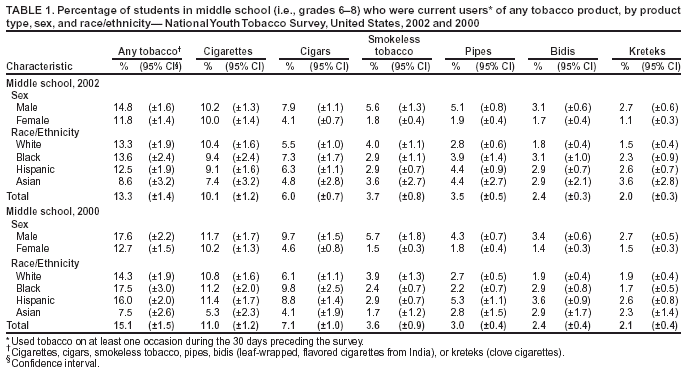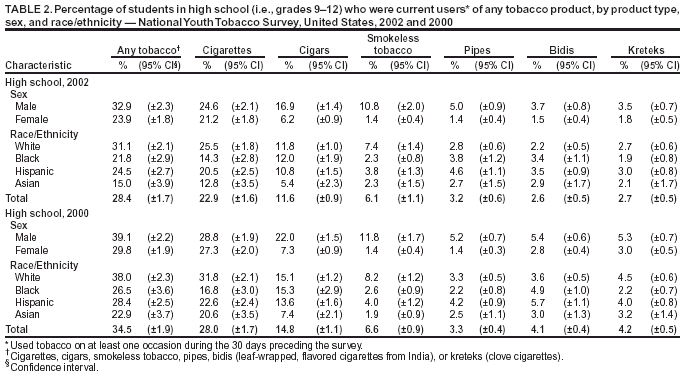 |
|
|
|
|
|
|
| ||||||||||
|
|
|
|
|
|
|
||||
| ||||||||||
|
|
|
|
|
Persons using assistive technology might not be able to fully access information in this file. For assistance, please send e-mail to: mmwrq@cdc.gov. Type 508 Accommodation and the title of the report in the subject line of e-mail. Tobacco Use Among Middle and High School Students --- United States, 2002Each day in the United States, approximately 4,400 youths aged 12--17 years try their first cigarette (1). An estimated one third of these young smokers are expected to die from a smoking-related disease (2). The National Youth Tobacco Survey (NYTS), conducted by the American Legacy Foundation, provides estimates of usage among U.S. middle and high school students for various tobacco products (i.e., cigarettes, cigars, smokeless tobacco, pipes, bidis [leaf-wrapped, flavored cigarettes from India], and kreteks [clove cigarettes]). This report summarizes tobacco use prevalence estimates from the 2002 NYTS and describes changes in prevalence since 2000. Both tobacco use and cigarette smoking among students in high school (i.e., grades 9--12) decreased by approximately 18% during 2000--2002; however, a decrease among students in middle school (i.e., grades 6--8) was not statistically significant. The lack of progress among middle school students suggests that health officials should improve implementation of proven antismoking strategies and develop new strategies to promote continued declines in youth smoking. Sampling frames for the 2002 NYTS were stratified by U.S. Census Bureau region; black, Hispanic, and Asian students were oversampled. A partial panel design was used (i.e., comprising a newly drawn sample and a sampling of schools that participated in the 2000 NYTS). The sampling frame for the drawn sample consisted of all public and private schools in the United States. A total of 94 primary sampling units (PSUs) (i.e., large counties or groups of counties) were selected in the first stage of the sampling, and 215 schools were selected from these PSUs in the second stage of the sampling; 83 additional schools were selected randomly for the panel sample. Of these 298 eligible schools, 246 (83%) participated in the 2002 NYTS. Approximately 125 students were then drawn from each school by selecting classes randomly, depending on the average class size of each school, from a required subject area (e.g., English or social studies). Participation was voluntary and anonymous, and school parental permission procedures were followed; students recorded their responses on a computer-scannable sheet. Among youths attending the 246 participating schools, 26,119 (90%) (i.e., 12,581 middle school students and 13,538 high school students) completed the survey, resulting in an overall response of 75%. Data were weighted to be nationally representative. STATA 7 was used to compute 95% confidence intervals for prevalence estimates, which were used to identify differences among populations. Current use of a specific tobacco product was defined as having used that product on at least one occasion during the 30 days preceding the survey. Current use of any tobacco product was defined as having used any of the listed products on at least one occasion during the 30 days preceding the survey. In 2002, a total of 13.3% of middle school students reported current use of any tobacco product (Table 1). Cigarettes (10.1%) were the most commonly used product, with no statistically significant differences in usage by sex. Cigars (6.0%) were the second most commonly used tobacco product, followed by smokeless tobacco (3.7%), pipes (3.5%), bidis (2.4%), and kreteks (2.0%). Males were more likely than females to use all tobacco products except for cigarettes. No significant differences were found for any type of tobacco use by race/ethnicity. Among high school students, 28.4% reported current use of any tobacco product (Table 2). Cigarettes (22.9%) were the most commonly used product, with no difference by sex; however, white students were more likely to use cigarettes than black, Hispanic, or Asian students. Cigars (11.6%) were the second most common tobacco product, followed by smokeless tobacco (6.1%), pipes (3.2%), kreteks (2.7%), and bidis (2.6%). Males were more likely than females to use all tobacco products except for cigarettes. Asian students were less likely to use cigars, and white students were more likely to use smokeless tobacco than students in other racial/ethnic groups. During 2000--2002, current use of any tobacco product among high school students decreased from 34.5% to 28.4%; cigarette use decreased from 28.0% to 22.9%, cigar use from 14.8% to 11.6%, bidi use from 4.1% to 2.6%, and kretek use from 4.2% to 2.7% (Table 2). However, no significant change was found among middle school students in the prevalence of tobacco use (Table 1). Reported by: JA Allen, MA, D Vallone, PhD, ML Haviland, DrPH, C Healton, DrPH, American Legacy Foundation, District of Columbia. KC Davis, MS, MC Farrelly, PhD, Research Triangle Institute, Research Triangle Park, North Carolina. CG Husten, MD, T Pechacek, PhD, Office on Smoking and Health, National Center for Chronic Disease Prevention and Health Promotion, CDC. Editorial Note:The declines in cigarette smoking and overall tobacco use among high school students reflect downward national trends since 1997 (3,4). The declining use of cigars, bidis, and kreteks and the unchanged use of smokeless tobacco and pipes among high school students suggests that students are not substituting other tobacco products for cigarettes and that efforts to reduce cigarette smoking might be reducing use of all tobacco products. However, the lack of any statistically significant decline in tobacco usage among middle school students is cause for concern. The findings in this report are subject to at least two limitations. First, these data apply only to youth who attended middle school or high school and are not representative of all youths in these age groups. Nationally, approximately 5% of youths aged 16--17 years were no longer in school (4). Second, the data were from self-reports of survey participants. Although underreporting of tobacco use by youths has been minimal in previous surveys (5), recent declines in the acceptability of smoking might have led to increased underreporting. Why middle school and high school students appear to be responding differently to the current antismoking environment is not clear. Factors expected to discourage youth from smoking include increases in cigarette prices (i.e., approximately 88% from December 1997 to December 2002) (6); implementation of smoke-free laws and policies; restrictions on tobacco advertising; and local, state, and national antitobacco campaigns (e.g., the truth® campaign) (7). However, spending on tobacco industry marketing doubled during 1997--2001 (8), and tobacco industry-sponsored media campaigns have been determined to reduce the impact of public health campaigns (7). The data in this report suggest that further refinements in evidence-based strategies will be needed to decrease tobacco use among middle school students. Efforts might focus on 1) devising more targeted and effective media campaigns, 2) reducing depictions of tobacco use in entertainment media (9), 3) instituting campaigns to discourage family and friends from providing cigarettes to youths, 4) promoting smoke-free homes, 5) instituting comprehensive school-based programs and policies in conjunction with supportive community activities, and 6) decreasing the number of adult smokers (e.g., parents) to present more nonsmoking role models. Because tobacco use is the leading cause of preventable death in the United States, efforts to reduce tobacco use must remain a public health priority. Preventing tobacco use among youth is essential to reduce future smoking-related illness and associated costs. However, in 2003, states cut spending for tobacco use prevention and control programs by $86.2 million (11.2%) (10). For the decline in tobacco use among youth in the United States to continue, such funding must be restored and perhaps expanded. References
Table 1  Return to top. Table 2  Return to top.
Disclaimer All MMWR HTML versions of articles are electronic conversions from ASCII text into HTML. This conversion may have resulted in character translation or format errors in the HTML version. Users should not rely on this HTML document, but are referred to the electronic PDF version and/or the original MMWR paper copy for the official text, figures, and tables. An original paper copy of this issue can be obtained from the Superintendent of Documents, U.S. Government Printing Office (GPO), Washington, DC 20402-9371; telephone: (202) 512-1800. Contact GPO for current prices. **Questions or messages regarding errors in formatting should be addressed to mmwrq@cdc.gov.Page converted: 11/13/2003 |
|||||||||
This page last reviewed 11/13/2003
|